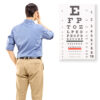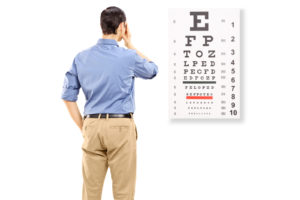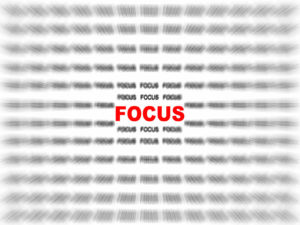
What Is 20/20 Vision?
You’ve probably often heard the phrase “hindsight is 20/20.” While you may know that’s a reference to having good eyesight, what does it actually mean to have 20/20 vision? Is it actually a good measure of eye health, or is it just an archaic saying of the past? In truth, 20/20 is a measure of visual acuity. While this measurement is important, it doesn’t tell the whole story of your vision. In this article, we’ll discuss what 20/20 vision is and ways you can improve your visual acuity.
 To begin, let’s talk about where the phrase “20/20” even comes from. Back in 1862, a Dutch ophthalmologist named Henry Snellen developed a chart to help measure people’s visual acuity. This chart, called the Snellen chart, is the classic poster you might read off of at the eye doctor or at your annual check up with your primary care doctor. When creating the chart, Snellen set the baseline of measurement at 20 feet. This is the approximate distance at which light rays entering the eye are parallel. In other words, our eyes don’t have to bend the rays to focus them upon the retina. Snellen set the standard of 20/20 vision to represent “normal sight,” or what a person with normal vision could see at a distance of 20 feet.
To begin, let’s talk about where the phrase “20/20” even comes from. Back in 1862, a Dutch ophthalmologist named Henry Snellen developed a chart to help measure people’s visual acuity. This chart, called the Snellen chart, is the classic poster you might read off of at the eye doctor or at your annual check up with your primary care doctor. When creating the chart, Snellen set the baseline of measurement at 20 feet. This is the approximate distance at which light rays entering the eye are parallel. In other words, our eyes don’t have to bend the rays to focus them upon the retina. Snellen set the standard of 20/20 vision to represent “normal sight,” or what a person with normal vision could see at a distance of 20 feet.
We normally associate the term 20/20 with good vision, which is fair. However, it does not represent perfect vision in all respects. In actuality, those will 20/20 vision have an average level of visual acuity.
Is 20/20 Vision Perfect Vision?
So, what do those numbers actually mean? 20/20 means you can see what the average person can see from 20 feet away. This means that a person with 20/40 vision must be 20 feet away to read what the average person can see from 40 feet away. In other words, they have poorer than average visual acuity. A person with 20/85 vision must be 20 feet away to read what the average person can read at 85 feet away, and so on.
As you can see, the Snellen Chart only measures visual acuity at a distance. It does not measure visual acuity at close ranges or peripheral vision. Similar charts were devised with smaller letters to read at a close range for the measurement of near vision. In short, one test, or one chart, cannot tell the whole story of visual health, but they can be a helpful starting point. As a case in point, you can score differently on various visual acuity tests. So, having 20/20 vision on the Snellen Chart isn’t enough to report perfect vision.
The Bad News
If your vision is not 20/20, then you are not alone.
Worldwide, over 2.2 billion people have visual impairments or are blind. Of that number, one billion people have impairments due to refractive errors. Refractive errors include conditions like nearsightedness and farsightedness. Presbyopia is another common refractive error that can be treated and prevented. That means 1 billion people suffering from blindness and impairments could have prevented their vision condition.
Leading Causes of Poor Vision
According to the World Health Organization, 80 percent of visual impairments are preventable and treatable. They’re commonly caused by cataracts, refractive errors, Trachoma, onchocerciasis, and vitamin A deficiencies. The leading causes of blindness are cataracts, glaucoma, and age-related macular degeneration (AMD). For some, these conditions are predisposed in their genes. If your mother, grandmother, and great-grandmother all had glaucoma, you might get it as well. But for most people, the lifestyle and health care you maintain over your lifespan can help prevent them.
The Good News
There are steps that you can take to prevent, delay, or halt the progress of the three major causes of blindness. Many of our previous posts have focused on the ways that you can prevent or halt the development of cataracts, glaucoma, and AMD. Enter any one of these conditions in the top right search bar on our site. You’ll see pages of results for each condition, many teaching you how to prevent and treat them.
In almost every vision-threatening condition, early detection is key. By getting regular eye exams, your eye doctor can notice subtle changes. They can perform different tests and monitor your changing vision. The Snellen Chart is just one of the tools they may use to assess your vision. By providing early diagnosis, you have more time to seek treatment and improve your vision. It’s especially important for children to get regular exams. Often, children don’t have the vocabulary or knowledge to tell you that something is wrong. Older adults should also get regular eye exams. Some vision conditions, like AMD, are more common over the age of 50.
If you haven’t yet tried eye vitamins to improve your vision, now is a good time to start. Eye vitamins can help with nearsightedness, farsightedness, astigmatism, and/or presbyopia (poor vision due to the aging process). There are 17 essential vitamins, minerals, and herbs that can greatly improve your vision naturally.
The Better News
Setting yourself a goal of reaching 20/20 vision is fine. However, keep in mind that any improvement is a step in the right direction. Allow time for the vitamins and diet changes to work. While they have been proven to improve vision, this is not an overnight cure for all vision problems.
We live in an era where everything we want is provided on demand. From TV shows to health care, convenience, and speed are our priorities. Unfortunately, this often leads people to get surgery or risky treatments out of convenience. Sometimes, the safest and most effective options aren’t the most convenient. Don’t be afraid to ask your eye doctor for natural options. And, make sure you fully understand the risks if you do choose to get eye surgery. Patience is key!
The Best News of All
Changing your diet will not only help your eyes become healthier. It will also help with your overall health. Many of the nutrients your eyes depend on are vital to your other organs as well. For example, antioxidants and iron. Being deficient in any of these nutrients will affect your eyes and other organs.
You may be considering a change to an eye-healthy diet which would include many fresh fruits and vegetables. In this diet, you’ll likely be eating more omega-3 fatty acids and dark-toned berries in addition to lots of leafy greens. You get a healthier, leaner, stronger body from eye-healthy diets. Two for the price of one is a pretty good deal!
Our Rebuild Your Vision Ocu-Plus Formula Contains All 17 Vitamins, Minerals, and Herbal Supplements to Improve Your Eye Health!












Leave Your Reply